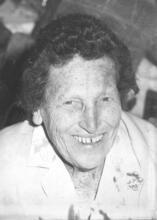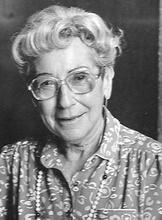Ruth Sperling
Ruth Sperling was born in Tel Aviv in 1939. After serving in the IDF she went to the Hebrew University, taking a first degree in chemistry and physics. In 1961, she married fellow student Yossi Sperling, who was also a scientist, specializing in organic chemistry. Ruth took a second degree in physical chemistry in 1964 and in 1969 gained a doctorate in biophysics from the Weizmann Institute of Science. In 1977 Ruth and Yossi joined forces on a major project. Their most important scientific achievement was of the 3-D structure of spliceosomes, the cell's "machinery" for chopping up and re-attaching pieces of DNA to create its requisite assortment of functional proteins. They continued working together until Yossi died suddenly in 2013.
Early Life and Family
Born into a family with a strong Zionist tradition and pioneer spirit, Ruth Sperling has kept this thread firmly woven through a life dedicated to scientific research. This research, pursued with her husband Professor Joseph “Yossi” Sperling, culminated in 2004 with the publication of a detailed 3-D structure of the spliceosome “machine.” Found in the nucleus of every cell, it is responsible for cutting and stitching together the stretches of genetic code which then make all the body’s 100,000 different proteins. The 3-D structure helps provide an insight into the functioning of this complex structure.
Ruth was born in Tel Aviv on August 7, 1939. A sister, Nava, born in 1943, was followed by a brother, Hillel (1947–2002). Her mother, Rachel (Bograshov) Allvail (b. Tel Aviv, 1908–1996), who held a BA from the Sorbonne, was an artist and teacher of children in the first grade. Although close to her mother, Ruth was strongly influenced by both her father, the artist Arieh Allvail (1901–1967), a graduate of the Vienna Academy of Art, and her maternal grandfather Hayyim Bograshov (Boger), describing them as “a major part of me.” Her grandfather (1876–1964), a fervent Zionist born in Chernigova (Crimea), settled in Palestine in 1905. In 1919 he became joint headmaster with Benzion Mossinson of the Herzlia Hebrew Gymnasia, founded by Yehuda Metman-Cohen in 1906. It was this school that Ruth attended from 1945 until 1957. Her father, a member of the Ha-Shomer ha-Za’ir youth movement, had come to Israel in 1920 from Poland as a halutz or pioneer. This Zionist youth movement was strongly influenced by Baden-Powell’s Scout Movement. Ruth herself became a member and subsequently a youth-leader in Zofim, the Israeli Scout Movement. She also acquired a lifelong love of art from her mother and father, covering the walls of her home with her father’s paintings. In 1957 she began two years of army service on Israel’s northern border.
Career and Impact
After her army service, Ruth went to the Hebrew University, taking a first degree in chemistry and physics (1959–1962, with distinction). She had made her decision to pursue a scientific career at around the age of thirteen, when she read a popular book about chemistry and “became curious to learn how things work.” On August 15, 1961, she married fellow student Yossi Sperling, whom she had known at school since the age of fifteen. His specialty was organic chemistry. Ruth took a second degree in physical chemistry in 1964 and in 1969 gained a doctorate in biophysics from the Weizmann Institute (both with distinction). On July 3, 1969, she gave birth to her daughter Galia. Ruth was determined to have children and continue working as a scientist. Six years later she gave birth to a son, Gil, and “always spent a major part of my salary on childcare” so that she could keep working.
From 1971 to 1973 Ruth and Yossi went together to pursue post-doctoral work at the Medical Research Council Laboratory of Molecular Biology in Cambridge, England, where Watson and Crick did their seminal work on DNA. Ruth worked under the brilliant chemist Aaron Klug, who developed the technique of crystallographic electron microscopy, receiving a Nobel Prize in 1982. Within the department there were regular informal meetings at which anyone could bat ideas around. On one occasion Francis Crick began talking about the organization of chromatin, and this stimulated a great deal of excitement. Chromatin is the term used to describe the mixture of DNA (genetic code) and the small basic proteins, histones, which together make up chromosomes. If one could take all the DNA out of a nucleus and stretch it out, it would end up a meter long, 5000-fold longer than when scrunched up in the nucleus. How is the compaction achieved? Is the packed DNA completely disorganized like balls of knitting wool? When scientists first looked at the tiny bundles of DNA, using an electron microscope, they could not detect any organized structure. Crick suggested that the chromatin enabled DNA to be compacted in a regular, organized way. Back in Israel, in 1973, Ruth began work at the Weizmann Institute on the histones in chromatin. She was able to show that these proteins, which constitute half of all chromatin, could assemble themselves into a long fibre with periodic, repeating structures. It is around this histone structure that the DNA is wound, thus providing a first-order compaction.
In 1977 a significant development in the field of genetics inspired Ruth and Yossi to join forces and collaborate on a major project that was to be the prime focus of their research for the next twenty-five years. The work in the United States of Richard Roberts at Cold Spring Harbor Laboratories and Phillip Sharp at MIT introduced the term “splicing” into the geneticists’ vocabulary, and in 1993 they received a joint Nobel Prize for this work. Splicing describes the way bits of genetic code are chopped out and stuck together to produce the required sequence which produces a particular protein. Fascinated by this work, the Sperlings decided in 1979 to combine the work in Ruth’s laboratory at the Hebrew University with that of Yossi at the Weizmann Institute and investigate the cell’s “splicing-machine,” the spliceosome.
Their joint effort, with that of their students, focused on taking material directly from cell nuclei and studying the splicing-machine which had been isolated from live cells. They rapidly froze their samples, preventing the damage caused by the formation of water crystals, and studied their samples under the powerful magnification of an electron microscope. This method contrasted with that employed by other groups who composed splicing-machines in test tubes using isolated components; these groups missed finding the pre-formed machines which the Sperlings discovered in cells. By 2004 they were ready to publish the 3-D structure of spliceosomes. These stunning pictures, with clear processing structures in the form of tunnels and a cavern, were composed from thousands of different images each at a slightly different angle.
During the twenty-five years devoted to this research, Ruth also worked as an active Zionist. She was a member (1985–1992) of the Israel Forum, which forged links between Israelis and Jews in the Lit. (Greek) "dispersion." The Jewish community, and its areas of residence, outside Erez Israel.Diaspora. She actively participated in the program that brought young Jews to Israel for a year, with her own family “adopting” a young woman studying biology in Israel. And when the massive Russian immigration arrived in Israel in the mid–1980s, Ruth and Yossi helped a Russian family set up their new lives. Over the years her research team has included several female/sing.; individual(s) who immigrates to Israel, i.e., "makes aliyah."olim (immigrants), for whom working in her laboratory helped to build their lives in Israel.
In 1991 Sperling became Professor of Genetics at the Hebrew University and in 1998, Director of the Center for Pre-Academic Studies at the Hebrew University. In 2004 this Center had over five hundred students who were being given a second opportunity to gain the necessary qualifications to pursue a university education. Despite the demands of this post, Ruth remained dedicated to the collaborative scientific research with her husband. They investigated the mechanisms of “alternative splicing,” where bits of genetic code are skipped as the sequence is assembled. It is this process which enables the body to produce in excess of 100,000 essential proteins even though it has only about 20,000 genes.
Sperling’s husband, Yossi, died suddenly in 2013.
Selected Works by Ruth Sperling
With J. Sperling. “Ribonucleoprotein (RNP).” In Encyclopedia of Molecular Biology, Vol. 4, edited by T. E. Creighton, 2185–2192. New York: 1999.
with L. A. Amos and A. Klug. “A study of the pairing interaction between protein subunits in the tobacco mosaic virus family by image reconstruction from electron micrographs.” J Mol Biol. 92 (1975): 541–558.
with M. Bustin and D. Goldblatt. “Chromatin structure visualization by immunoelectron microscopy.” Cell. 7 (1976): 297–304.
with M. Bustin. “Histone dimers: a fundamental unit in histone assembly.” Nucleic Acids Res. 3 (1976): 1263–1275.
with E. J. Wachtel. The histones. Adv. Protein Chem. 34 (1981): 1–60.
with P. Spann, M. Feinerman and J. Sperling. “Isolation and visualization of large compact ribonucleoprotein particles of specific nuclear RNAs.” Proc Natl Acad Sci U S A. 86 (1989): 466–470.
with A. J. Koster, C. Melamed-Bessudo, A. Rubinstein, M. Angenitzki, Z. Berkovitch-Yellin and J. Sperling. “Three-dimensional image reconstruction of large nuclear RNP (lnRNP) particles by automated electron tomography.” J Mol Biol. 267 (1997): 570–583 (1997).
with S. Muller, B. Wolpensinger, M. Angenitzki, A. Engel and J. Sperling. “A supraspliceosome model for large nuclear ribonucleoprotein particles based on mass determinations by scanning transmission electron microscopy.” J Mol Biol. 283 (1998): 383–394.
with O. Medalia, M. Heim, R. Guckenberger and J. Sperling. “Gold-tagged RNA-A probe for macromolecular assemblies. J. Struct. Biol. 127 (1999): 113–119.
with O. Raitskin, D. S. Cho, J. Sperling and K. Nishikura. “RNA editing activity is associated with splicing factors in lnRNP particles: The nuclear pre-mRNA processing machinery.” Proc. Natl. Acad. Sci. USA 98 (2001): 6571–6576.
B. Li, C. Wachtel, E. Miriami, G. Yahalom, G. Friedlander, G. Sharon, and J. Sperling. “Stop codons affect 5’ splice site selection by surveillance of splicing.” Proc. Natl. Acad. Sci. USA 99 (2002): 5277–5282.
E. Miriami, U. Motro and J. Sperling. “Conservation of an open reading frame as an element affecting 5’ splice site selection.” J. Struct. Biol. 140 (2002): 116–122.
M. Azubel, S. G. Wolf and J. Sperling. “Three-dimensional structure of the native spliceosome by cryo-electron microscopy.” Mol. Cell 15 (2004): 833–839.
C. Wachtel, B. Li and J. Sperling. “Stop codon mediated suppression of splicing is a novel nuclear scanning mechanism not affected by elements of protein synthesis and NMD.” RNA 10 (2004): 1740–1750.
















